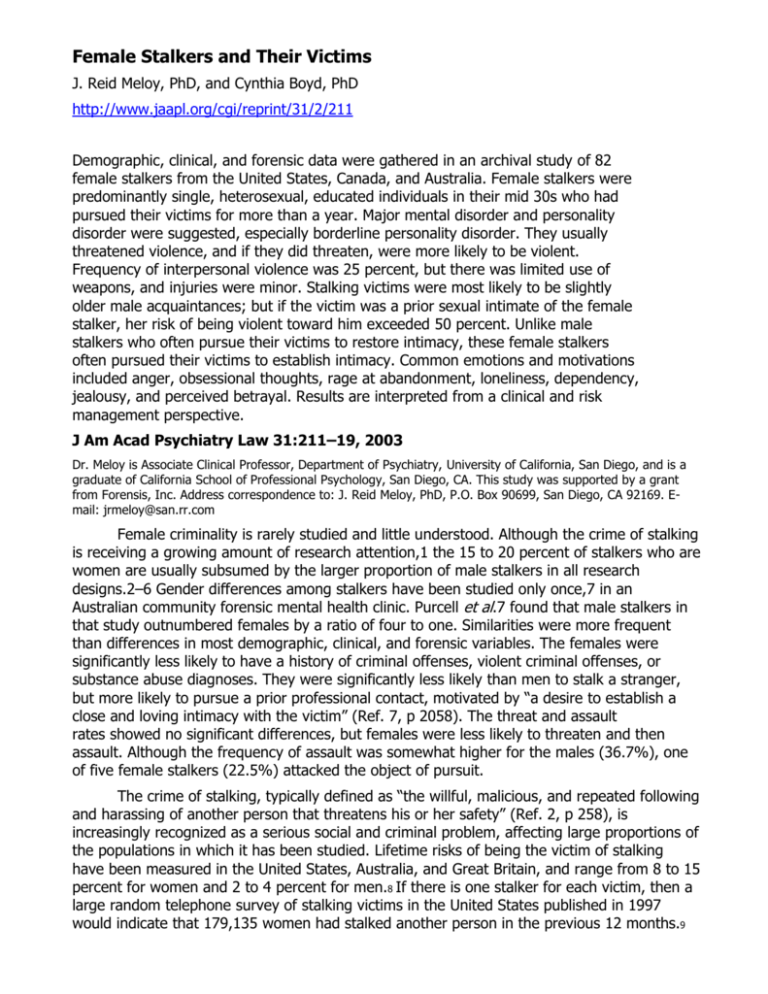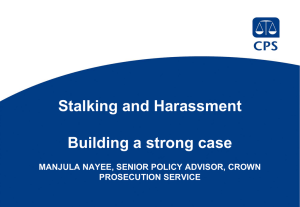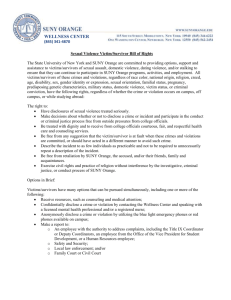
Female Stalkers and Their Victims
J. Reid Meloy, PhD, and Cynthia Boyd, PhD
http://www.jaapl.org/cgi/reprint/31/2/211
Demographic, clinical, and forensic data were gathered in an archival study of 82
female stalkers from the United States, Canada, and Australia. Female stalkers were
predominantly single, heterosexual, educated individuals in their mid 30s who had
pursued their victims for more than a year. Major mental disorder and personality
disorder were suggested, especially borderline personality disorder. They usually
threatened violence, and if they did threaten, were more likely to be violent.
Frequency of interpersonal violence was 25 percent, but there was limited use of
weapons, and injuries were minor. Stalking victims were most likely to be slightly
older male acquaintances; but if the victim was a prior sexual intimate of the female
stalker, her risk of being violent toward him exceeded 50 percent. Unlike male
stalkers who often pursue their victims to restore intimacy, these female stalkers
often pursued their victims to establish intimacy. Common emotions and motivations
included anger, obsessional thoughts, rage at abandonment, loneliness, dependency,
jealousy, and perceived betrayal. Results are interpreted from a clinical and risk
management perspective.
J Am Acad Psychiatry Law 31:211–19, 2003
Dr. Meloy is Associate Clinical Professor, Department of Psychiatry, University of California, San Diego, and is a
graduate of California School of Professional Psychology, San Diego, CA. This study was supported by a grant
from Forensis, Inc. Address correspondence to: J. Reid Meloy, PhD, P.O. Box 90699, San Diego, CA 92169. Email: jrmeloy@san.rr.com
Female criminality is rarely studied and little understood. Although the crime of stalking
is receiving a growing amount of research attention,1 the 15 to 20 percent of stalkers who are
women are usually subsumed by the larger proportion of male stalkers in all research
designs.2–6 Gender differences among stalkers have been studied only once,7 in an
Australian community forensic mental health clinic. Purcell et al.7 found that male stalkers in
that study outnumbered females by a ratio of four to one. Similarities were more frequent
than differences in most demographic, clinical, and forensic variables. The females were
significantly less likely to have a history of criminal offenses, violent criminal offenses, or
substance abuse diagnoses. They were significantly less likely than men to stalk a stranger,
but more likely to pursue a prior professional contact, motivated by “a desire to establish a
close and loving intimacy with the victim” (Ref. 7, p 2058). The threat and assault
rates showed no significant differences, but females were less likely to threaten and then
assault. Although the frequency of assault was somewhat higher for the males (36.7%), one
of five female stalkers (22.5%) attacked the object of pursuit.
The crime of stalking, typically defined as “the willful, malicious, and repeated following
and harassing of another person that threatens his or her safety” (Ref. 2, p 258), is
increasingly recognized as a serious social and criminal problem, affecting large proportions of
the populations in which it has been studied. Lifetime risks of being the victim of stalking
have been measured in the United States, Australia, and Great Britain, and range from 8 to 15
percent for women and 2 to 4 percent for men.8 If there is one stalker for each victim, then a
large random telephone survey of stalking victims in the United States published in 1997
would indicate that 179,135 women had stalked another person in the previous 12 months.9
The purpose of this study was to assemble a sample of cases of stalking by females and
study their various demographic, clinical, and forensic characteristics. Given the relatively small
number of women charged with or convicted of stalking in any one jurisdiction, we attempted
to gather cases from as many different collaborators in as many different geographical
locations as possible, to increase the external validity of our findings.
Methods
The study design was an archival survey of mental health and law enforcement
professionals. A static group comparison was used to test certain hypotheses within the
sample. Research collaborators who were professionals with expertise and experience
in stalking cases were sought from the United States, Canada, and Australia between June
2000 and March 2001. These professionals were known to the first author, in some cases
through their research publications. Stalking cases were included based on the following
selection criterion: an adult female (18 or more years of age) who had engaged in
stalking behavior as defined by the California Penal Code: “. . .any person who willfully,
maliciously, and repeatedly follows or harasses another person and who makes a credible
threat with the intent to place that person in reasonable fear for his or her safety, or
the safety of his or her family.”10 Specific charges or convictions were not necessary for
inclusion, but the behavior had to have occurred on more than one occasion.
The survey instrument was developed by the authors based primarily on published
research studying male perpetrators. It consisted of 140 categorical questions distributed
across 11 sections: (1) perpetrator demographics; (2) psychiatric and
psychological information; (3) use of drugs or alcohol; (4) criminal history; (5) patterns of
pursuit; (6) emotions and motivations for stalking; (7) threats; (8) violence; (9) escalation;
(10) victim characteristics; and (11) victim response. The survey instrument is available from
the authors. Because of the archival nature of the study, the subject’s consent was
unnecessary. Subjects were not identified by name. Data were analyzed on computer with
SPSS 9.0 for Windows. Frequencies and percentages were calculated based on the sufficiency
of the data to determine the presence or absence of each variable. Inferential
hypotheses were tested using chi-square analysis. Statistical significance was set at .05.
Results
Thirty-nine individuals responded to requests for participation as our research
collaborators. Thirtythree (84.6%) completed and returned the survey instrument: 20 mental
health professionals, 8 law enforcement professionals, 1 private security professional, 3
stalking victims, and 1 relative of a stalking victim. Data used to complete the research
instrument were gathered from the case files of the research collaborators. Eighty-two cases
of stalking by females were entered into our database from the United States (n_62), Canada
(n_10), and Australia (n_
10).
Perpetrator Demographics
The subjects’ ages ranged between 18 and 58 years (mean, 37; SD, 9.50). Most were
white (n _ 61; 77%), and the remainder were African American (n _ 6; 8%), Asian (n _ 5;
6%), Hispanic (n _ 4; 5%), and other (n _ 3; 4%). (When the total number does not reach 82,
data for the particular variable were missing.) Eighty-eight percent (n _ 68) had achieved at
least a high school degree. Thirty-eight percent had a college or graduate degree.
Although reliable IQ data were available on only 24 subjects, 96 percent had an estimated
average to superior IQ (n _ 23).
Eighty percent of the subjects were heterosexual (n _ 60), 8 percent lesbian (n _ 6),
and 12 percent bisexual (n_9). Fifty-eight percent were single (n_ 45), 13 percent were
married (n _ 10), and 21 percent were divorced (n _ 16). Sixty-seven percent were childless (n
_ 55), and 33 percent had one or more children (n _ 27). Seven percent had three to five
children (n _ 6).
Forty-five percent (n_18) had a history of sexual abuse, 30 percent (n _ 12) had
experienced physical abuse, and 8 percent (n _ 3) had suffered emotional trauma. However,
data on these abuse variables were missing for half of the subjects.
Psychiatric and Psychological Information
Only a subsample of subjects could be reliably evaluated for Axis I (n _ 24) and Axis II
(n _ 22) diagnoses. Axis I diagnoses, in descending order of frequency, included delusional
disorder (n_5), major depression (n _ 4), schizophrenia (n _ 3), dysthymia (n_2), bipolar
disorder (n_2), adjustment disorder (n _ 2), schizoaffective disorder (n _ 2), and psychotic
disorder not otherwise specified (NOS) (n _ 2). Axis II diagnoses, in descending order of
frequency, included borderline personality disorder (n _ 10), narcissistic personality disorder (n
_ 3), dependent personality disorder (n _ 3), personality disorder NOS (n _ 2), and
obsessivecompulsive personality disorder (n_1). One female had a diagnosis of more than one
personality disorder. Half of the females (49%) who were psychiatrically evaluated at the time
they engaged in stalking (n _ 39) were judged to be psychotic. The most prominent psychotic
symptoms were delusions (n _ 14). One-third (n _ 27) of the women had at least one inpatient
psychiatric admission by history. In the
year prior to the stalking, 38 percent of the women (n_25) had suffered at least one
major personal loss, usually a relationship. Seventeen percent (n _ 11) reported multiple
losses, such as a relationship, finances, child custody, and a home.
Use of Drugs or Alcohol
Three-fourths of the women (n _ 49) denied a substance abuse history. One-third of
the women, however, reportedly used the following substances while they were stalking, in
descending order of frequency: alcohol (n _ 17), cannabis (n _ 10), amphetamines (n _ 4),
opiates (n _ 1), and sedativehypnotic drugs (n_1). There was no reported use of cocaine,
hallucinogens, phencyclidine (PCP), or steroids.
Criminal History
Twenty-eight (37%) of the female stalkers had an adult criminal history prior to
stalking, but only three (7%) had an available juvenile history of crime. Sixteen percent (n_13)
had one to four prior arrests for stalking other individuals.
Patterns of Pursuit
The female stalkers were most often prior acquaintances of the victim (n _ 40, 50%).
Twenty-seven percent (n _ 22) were prior sexual intimates of the victim, 21 percent (n _ 17)
were strangers, and 2 percent (n _ 2) were family members. Various means were used to
pursue their victims in these contexts and are listed in Table 1. Multiple approaches were used
by most of the stalkers. Slightly less than half of the subjects (n _ 40, 49%) actually
followed their victims.
Emotions and Motivations
Table 2 presents the emotions and motivations for the female stalkers, as reported by
the research collaborators from police reports, victims’ reports, witness testimony,
psychotherapists’ reports, and selfreports. The categories were derived from the
extant research. More than one emotion or motivation was reported in most cases.
Threats
A threat was defined as a “written or oral communication that implicitly or explicitly
states a wish or intent to damage, injure, or kill the target” (Ref. 11, p 90). Sixty-five percent
(n_50) of the female stalkers threatened their victims. Forty-one women threatened orally, 23
wrote threats, and 34 threatened multiple times. Nineteen women made homicidal threats.
Threats were divided into two categories: expressive and instrumental.11 Expressive
threats are primarily used to regulate affect in the threatener and are often inferred through
the ventilation of anger or frustration (an example from our study: “I’ll wreck his business!!!”).
Instrumental threats are used to control or influence the behavior of the victim
Table 1 Patterns of Pursuit Used by Female Stalkers
Made telephone calls and/or left messages
Sent letters and unwanted gifts
Drove by home, office, or school
Trespassed on property
Followed the victim
Expressed affection 39 48
Intruded on victim’s family, friends, or coworkers
Intruded in private interactions
Vandalized victim’s property
Used surveillance techniques
Attempted to break and enter
Stole or damaged victim’s possessions
Involved victim in unwanted activities
E-mailed victim
N
68
63
59
56
40
%
83
78
73
69
49
34
27
25
22
21
15
13
11
42
33
31
27
26
19
16
14
n
%
63
63
44
37
37
33
33
Total percentage exceeds 100% because multiple patterns of pursuit were
used by many stalkers. In the first variable, N _ 82; all others, N _ 81.
Table 2 Emotions and Motivations for Stalking
Anger/hostility
Obsession
Rage at abandonment
Loneliness
Dependency
Jealousy
Betrayal
49
49
34
29
29
26
26
Sexual preoccupation
Retaliation
Need for power and control
Sexual intent
Attempted reconciliation
Projection of blame
Humiliation and shame
Social incompetence
Envy
Recent loss
Distress over divorce
Under the influence of alcohol/drugs
Distress over custody dispute
Grief
Total percentage exceeds 100% due to more than one emotion or motivation
reported in each case for most subjects. In the Envy category, N _ 79; all
others, N _ 78
20
19
15
14
14
13
9
9
9
7
5
5
2
1
26
24
19
18
18
17
12
12
12
9
6
6
2
1
through an aversive outcome (an example from our study: “Don’t ever call me crazy. I
don’t want to hurt you like I did the others”). Forty women made expressive threats, and 42
made instrumental threats. Most women made both expressive and instrumental threats. The
threats were followed by personal violence toward the victim in 15 (30%) cases, which is the
true-positive rate. The false-positive rate would therefore be 70 percent. There was, however,
a falsenegative rate of 15 percent (n _ 3), which refers to the female stalkers who became
personally violent who did not communicate a threat beforehand. There was no significant
relationship between prior sexual intimacy and the presence of a threat (_2 [1, n _ 77] _ 1.16,
p _ .281).
Violence Toward Person and Property
Violence was defined as “an intentional act of aggression directed toward a specific
human being or property which physically injures or damages, or is likely to physically injure or
damage, the person or property” (Ref. 12, p 6). Twenty-five percent (n _ 20) of the female
stalkers were physically violent toward the victims.
Other aspects of violent behavior were reported for only a small subsample of women
and are represented in Table 3. In most cases when data were available, the injury to the
victim did not require medical care. When a weapon was used, it was usually a knife, gun, or
automobile. Other weapons included a brick, rock, purse, book, garden hoe, and portable
electric fan. There were 83 victims in this study, and 3 were killed by their female stalkers.
In most cases the violence was affective (emotional, reactive) rather than predatory
(unemotional, planned).13–14 All of the homicides were predatory when analyzed according to
forensic criteria.14
There was a significant relationship between prior sexual intimacy and violence toward
the victim (_2 [1, n _ 77] _ 10.62, p _ .05). The strength of this relationship was moderate (_
_.37, p_.05). Fiftyfive percent of the prior sexual intimates were violent; 15 percent of the
remainder of the sample were violent. Acquaintance status and violence toward the victim was
also significantly related (_2 [1, n_79]_ 4.02, p _ .05). The strength of this relationship
was mild (_ _ .23, p _ .05). There was no significant relationship between stranger status and
violence. The presence of a threat and subsequent acts of violence toward the victim was
positively and significantly related (_2 [1, n _ 76] _ 4.30, p _ .05). The strength of this
relationship was mild (_ _ .24, p _.05).
Table 3 Violence Toward the Victim Among Female Stalkers
Total Sample,
N
n
Interpersonal violence
80
20
Toward victim only
8
Toward victim and property
12
No violence
60
Property violence
78
Present
19
Absent
59
Violence reported more than once
29
Present
17
Absent
12
Injury requiring medical care
23
Present
2
Absent
21
Weapon use
26
Present
12
Absent
14
Type of weapon used*
12
Knife
4
Gun
3
Auto
3
Other
6
Weapon caused injury
12
Yes
4
No 8 67
Weapon caused death
25
Yes
3
No
22
%
25
10
15
75
24
76
59
41
9
91
46
54
33
25
25
50
33
12
88
* In some cases, more than one type of weapon was used by the subject;
therefore, n _ 12 for this variable.
Escalation
The female stalkers had contact with their victims daily (n _ 37, 52%), weekly (n _ 24, 34%),
or monthly (n _ 10, 14%). The duration of stalking lasted less than 1 year in 23 (32%) cases ;
from 1 to 5 years in 38 (54%) cases; from 6 to 10 years in 9 (13%) cases; and more than a
decade in 1 case. Escalation was defined by an increase in frequency of contact during the
course of stalking (n _ 51, 66%) and an increase in intrusiveness (n _ 55, 73%). For example,
the number of letters sent would increase over a set period of time (frequency), or letter
writing as a method of pursuit would be supplanted by physical following (intrusiveness).
Although the stalking activity of the majority of female stalkers escalated according to our
definition, we did not measure the magnitude of the intrusiveness or the rate of increase in
frequency.
Table 4 Victims’ Responses and Means of Protection
Total Sample,
N
n
Documented evidence of stalking
63
47
Obtained temporary restraining order
80
53
Used a team approach*
66
43
Changed habit patterns
65
36
Reported each incident to police
62
33
Increased home/work security
65
28
Changed telephone number
66
16
Changed address
66
10
Carried a weapon
65
5
Sought psychotherapy
59
5
Changed place of employment
66
4
Total percentage is more than 100% because of multiple methods
%
75
66
65
55
53
43
24
15
8
8
6
used by most victims.
* Team consisted of victim, law enforcement, mental health professional, and
friends.
Victims’ Characteristics
The victims of the female stalkers were mostly males (n _ 52, 67%). Ninety percent (n
_ 72) were white, five percent (n _ 4) were Hispanic, two percent (n_2) were African
American, and one percent (n _ 1) was Asian. Their ages ranged from 16 to 68 years (mean,
41.30; SD, 11.08). Ninety-four percent (n _ 74) were heterosexual. Forty-six percent (n _ 36)
were married, 17 percent (n _ 13) were divorced, and 27 percent (n _ 22) were single. Half
of the victims had no dependents (n _ 43, 52%).
Victims’ Response to Stalking
Eleven of the victims (six females and five males) had been stalked in the past, usually
by a stranger (n _ 7). Only two were stalked previously by a prior sexual intimate and three by
an acquaintance. Onethird of the victims initiated contact with the female stalkers after the
stalking began (n_22), which subsequently increased the stalking behavior in 68 percent of
these cases (n _ 15). It reportedly decreased stalking behavior in one case and had no effect
in six cases. A complete list of victims’ responses is listed in Table 4.
Ninety-seven percent of the victims were reportedly aware that they were ultimately
responsible for their own personal safety, and 90 percent reported positive treatment by law
enforcement.
Discussion
This study has several limitations. We were not able to evaluate most of the female
subjects clinically, although 20 mental health professionals provided clinical data on a
subsample. We were dependent on the observation and interpretation of data from
other professionals without standard measures of reliability. Our clinical data are particularly
weak, given the absence of structured interviews and psychological testing for most
subjects. As with all archival studies, we had missing data and were therefore precluded from
making statistical predictions.
As with all survey studies, we had no control or comparison group. Given the small
number of female stalkers available anywhere for study, our 82 subjects were selected
nonrandomly, limiting the generalizability of our findings. We attempted to compensate for this
limitation by drawing subjects from many different geographical locations in three different
countries. There were also no medical evaluations of our subjects, an important
limitation given the presence of organic and/or neurological problems in two studies of a small
sample of male stalkers.24,33 Despite these shortcomings, we think our findings establish some
important groundwork for further research.
Female stalkers appear to be similar to male stalkers in age and relationship status:
most appear to be single women in their mid-30s. Purcell et al.7 found the median age of their
sample to be 35, and male stalkers are consistently found to be in their mid 30s and
unmarried.2–6 A history of failed sexual pair bonds appears to mark both male and female
stalkers. The crime of stalking, moreover, is labor intensive, and it is a testament to either
their desperation or efficiency, or both, that one-third of the female stalkers were probably
raising children at the same time.
Once again, education and IQ appear to be higher among female stalkers than female
criminals in general, a finding that has been replicated in male samples. 6 Female stalkers
appear to be smart and educated, which may translate into a criminal sophistication that,
despite their other disabilities, may contribute to the successful pursuit of their male victims.
Although the physical and sexual abuse data are limited, such abuse is disturbingly prominent
and similar to findings in other samples of female criminals. 15 It also suggests a traumagenic
rather than constitutional basis for the high frequency of borderline personality disorder
among the female stalkers16 and raises the probability of post-traumatic stress
disorder (PTSD).
Although our psychiatric data were also limited, when evaluations were available, most
of the women had both Axis I and Axis II diagnoses. As in males, Axis I conditions varied
among the women and clustered around depression, psychosis, or both. The absence of any
anxiety disorders, particularly PTSD, was unexpected and inconsistent with the prevalence of
borderline personality disorder. One in five women with a verifiable Axis I diagnosis had
delusional disorder, a rare condition even among psychiatric patients, but one that may occur
more frequently among female than male stalkers. Delusional disorder has been shown to be
more frequent in females than in males in civil mental health settings.17
Axis II disorders appear to follow the pattern among men, with Cluster B personality
disorders most likely. Borderline personality disorder was expected and found for three
reasons: first, it is most often diagnosed in women; second, it is defined in DSM-IV by its
intensity, instability, and a fear of abandonment; and third, it correlates with an
underlying “preoccupied” attachment pathology in the domestic violence and stalking literature
concerning men.18 Object relations theory suggests that individuals with preoccupied
attachments hold a positive emotional valence toward others (idealization) and a negative
emotional valence toward themselves (devaluation). 19 Their internal representations are
part object related and preoedipal.20 They are likely organized at a borderline level of
personality.21
Suggestively absent among the female stalkers is antisocial personality disorder (ASPD).
This finding is similar to the low rate of ASPD (and psychopathy by inference) among male
stalkers—usually less than 10 percent.6 Typical rates of ASPD among male offenders are 50 to
75 percent.22 These findings are likely a product of gender differences for the ASPD diagnosis
and the absence of a dismissive attachment pathology: an internal working model in which
others are devalued and the self is idealized, a narcissistic stance from which others are used,
exploited, and discarded, rather than desperately sought.23 A significant personal loss for many
of the women in our sample during the year before the onset of stalking may have further
precipitated such pursuits, or at least exacerbated the underlying, insecure attachment style.18
Kienlen et al.24 found that 80 percent of a small sample of imprisoned male stalkers had had a
significant personal loss (relationship or employment) in the 7 months preceding the onset of
stalking. Most of the subjects in Kienlen et al. also suffered a change or loss of a primary
caretaker during childhood.
Prior research in male stalkers indicates that most knew their victims, and the most
common prior relationship was sexual intimacy (45–50%).2–6 In our study the most common
prior relationship was “acquaintance,” while prior sexual intimacy had occurred in only one of
four cases. The female stalker was a complete stranger to the victim in one of five cases.
Purcell et al.7 had almost exactly the same finding for sexual intimacy in their sample of 40
female stalkers, 10 of whom are included in our study. Other studies of male stalking victims
are consistent with these findings. Hall25 reported that two-thirds of male victims in her study
were stalked by prior acquaintances, not intimates, and Tjaden and Thoennes9 found that
males tend to be stalked by female acquaintances and strangers, not by prior sexual intimates.
These results, which are a significant departure from those showing that victims of most male
stalkers are prior sexual intimates, provide suggestive support for the theory of Purcell et al.7
that female stalkers are motivated to establish intimacy with their victims, whereas male
stalkers are attempting to maintain intimacy with their former partners. Pursuit behavior of the
females was multiple and varied, as was true of male stalkers.4,6,8 It appears, however, that
the most frequently prohibited act in stalking laws, following the victim, is engaged in
less often by females than by males. Our finding of 49 percent following their victims is
virtually identical with the 50 percent who followed their victims in Purcell et al.,7 which, in
turn, was significantly less than their male comparative sample. Among male stalkers, 48 to 80
percent follow their victims.2–6 Perhaps unwanted following is more overtly
aggressive, therefore more likely to be a male stalking behavior. The women, moreover,
appear to be creatively aggressive in more covert ways: they intrude on the victim’s
associates, vandalize property, use surveillance, break and enter, and steal the
victim’s possessions. All of these patterns do not risk a direct physical confrontation with the
male victim, at least for the moment.
What motivates female stalkers? Anger and hostility were reported in two-thirds of our
sample, as it was in 55 percent of a previous sample of male stalkers. 6 The commonality of
obsession, perhaps a cognitive corollary of anger in these women, gives further credence to
the prominent role of preoccupied thoughts among all stalkers.1,4,8 Rage caused
by abandonment in half the sample is consistent with a diagnosis of borderline personality
disorder and may reactivate early feelings and fears, whether real or imagined, of parental
neglect. Such rage toward the victim is likely to be based on transference perceptions and
feelings, perhaps psychotic ones, since at least half of the abandonment-related rage was
reported in our subjects who had no prior intimate relation with their victims.
Other feelings common to the ennui of human experience—loneliness, dependency,
jealousy, a desire to retaliate, and a need for power and control— are present among female
stalkers, but may need a diagnosable psychiatric condition to be acted out in aberrant and
unwanted behavior. Such conditions may defeat one lesson to be learned in the course
of maturation: internal states can be felt without being acted on. As in other studies of
stalking,6 explicit sexual motivations appear to be unusual.
Although the fertile ground for stalking by males—social isolation, loneliness, and social
incompetence— is also suggested by our data for females, the role of pathological narcissism,
specifically entitlement and grandiosity in the form of narcissistic linking fantasies, seems
less.11 The women seem more intent on forming an attachment, regardless of the negative
consequences, to assuage feelings of loneliness, dependency, and anger, rather than to
restore a narcissistically idealized relationship, which often characterizes male stalkers. Female
stalkers threaten their victims at about the same rate as males (50–75%).26 We also found
a greater likelihood of violence if a threat was communicated by the female stalker to her
victim. The strength of this relationship was mild, however—a finding similar in male
stalkers.5,12 This finding underscores an important risk management axiom: threats in private
stalking cases increase risk, but because they are so common they should not be used
to predict violence. An analysis of verbalized threats should be secondary to an analysis of
behavior that may pose a danger to the victim.27
We discovered that threats issued by female and male stalkers are acted on at a similar
rate. Truepositive rates for males are 25 to 35 percent.28 The true-positive rate for this sample
of female stalkers for personal violence was 30 percent. The false-negative rate (no threat
followed by violence) is low, as expected and within the range of that of male stalkers (13–
23%; Ref. 28) of private parties, usually prior sexual intimates. If a female stalker does not
threaten, there appears to be a one in seven chance that she will attack the victim.
The frequency of interpersonal violence among male stalkers is 25 to 40 percent.28
When prior sexual intimates are the victims, violence frequency substantially exceeds 50
percent.5,12 Female stalkers are no different. When prior sexual intimates were victimized, the
frequency of violence substantially increased to 55 percent. Purcell et al.7 reported an
assault rate of 22.5 percent for all of their female stalkers, almost identical to our overall
finding for interpersonal violence.
The good news is that the violence was not serious in most cases, did not require
medical care for the injuries sustained, and did not involve a weapon (see Table 3). Even
when a weapon was used, our limited data suggest that it did not cause injury in two of three
cases. This finding is similar to that of Meloy et al.12 who reported no injury when a weapon
was used in a sample of male stalkers (n _ 59). Their finding suggested that weapons were
used to frighten, intimidate, or control, rather than to injure the victim. Female stalkers may
have a similar motivation when they brandish a knife or a gun.
Violence research involving study of male stalkers has also confirmed a strong and
significant relationship between risk of violence and prior sexual intimacy with the victim.12 One
study found that it predicted violence correctly 97 percent of the time.12 We tested this
hypothesis with female stalkers by using nonparametric comparisons and found the same,
albeit weaker, relationship. Interpersonal violence had a moderate association with prior
sexual intimates, a mild association with acquaintances, and no association with strangers. It
appears that risk of violence weakens as the interpersonal relationship between parties is more
distant. The more actual detachment in the relationship between female stalker and victim,
the more idealized the relationship may remain, with room for the victim to maneuver
psychologically to avoid direct anger and hostility. For example, third parties may provide a
convenient target for the displacement of aggression29 in the face of actual rejection. Psychotic
diagnoses are also significantly more prevalent among male stalkers who pursue strangers6,24
(we had insufficient data to test this in our female sample), and female stalkers who
are delusional, perhaps erotomanically so, could more easily maintain their irrational beliefs in
the midst of actual rejection. Whatever the basis for continuous could also diminish the
intensity of emotions of anger, jealousy, or fear of abandonment, the fuel for affective
violence.11
The estimated homicide rate among male stalkers is 0.25 percent.30 We had two
subjects who intentionally killed three victims in this study, but our sample is too small to
construct a valid homicide rate for female stalkers. Both women lived in San Diego County,
California; were prior sexual intimates of the victims; and committed acts of predatory
violence that were planned, purposeful, and emotionless. In the first case a 26-year-old
woman threatened and intruded on her former boyfriend for more than a year, rented an
apartment near him, and shot him to death with a .357 magnum revolver in front of
his apartment. Psychological testing indicated an average IQ. Her evaluating psychologist and
psychiatrist concurred that she had a borderline personality disorder with antisocial features.31
In the second case, a 41-year-old woman engaged her former husband in five years of
vandalism, threats, telephone calls, trespassing, property damage, and financial and
child custody disputes. She then shot and killed him and his new wife with a .38 caliber
revolver in the early morning hours as they lay sleeping in their bed.31 At trial, her diagnosis
was major depression and borderline personality disorder with narcissistic and
histrionic features. One of us corresponded with this individual during the course of this study,
and she wrote of her victim, “[He] was a sick bastard with a lot of power with the crooked
judges who ran those courts in the 1980s.” She had been in prison for more than a decade.
All violent offenders of both genders tend to target same-gender victims 70 to 75
percent of the time.15 This was not the case in our study. The violent female stalkers targeted
males 67 percent of the time. Our findings suggest that stalking, whether violent or not, is a
crime that usually occurs between sexes, regardless of the gender of the perpetrator, and
samegender stalking is the exception to the rule.8 The abnormal desire to establish a
heterosexual pair bond with an unwilling person may subsume the violent patterns seen
among other kinds of female criminals.
Most female stalkers pursue their victims for one to five years. Although we had no data
to determine the mean length of the sample’s pursuits, this range falls within the expected
duration of most stalking cases, which is 1.8 years.9 In Mullen et al.8 a large sample of
Australian stalkers, both men and women, had durations of stalking ranging from 8 to
38 months. Their female stalkers had a median duration of stalking of 22 months.7
Victims of female stalkers, on average, were men at least a decade older than the
female victims of male stalkers. Tjaden and Thoennes9 reported an average age of 28 in their
random probability telephone survey in the United States of victims of stalking.
Female stalkers and their victims are almost chronological peers, the women averaging 37 to
38 years and the men averaging 40 to 41 years of age. There is an evolutionary symmetry to
all these data, even though the behavior is maladaptive; most men pursue younger women for
sexual pair bonding, and most women prefer older men for sexual pair bonding.32 Women are
more likely than men, however, to engage in same-sex stalking. One-third of the victims in our
study were women, while Purcell et al.7 found that almost half of the victims in their study
were women. The reason for these findings remains elusive.
The victims responded to their female stalkers with a range of coping behavior (see
Table 4) that reflect attempts to avoid the stalker, legally limit her ability to approach the
victim, and actively help law enforcement build a criminal case against her. Our data present
an unduly optimistic picture, however, because most victims of stalking, whether male
or female, do not report the incidents to the police.9 In our study, the active victim response is
a product of selection bias, since virtually all our subjects were provided to us by law
enforcement or mental health. We do not know how well these strategies worked, but we do
know that direct confrontation of the female stalker by her victim usually did not. Among the
22 victims who initiated contact with the female stalker after it began, the stalking increased
68 percent of the time. This is the first empirical support for the assertion1,26 that any type of
initiated contact, regardless of the words or affect exchanged, is an intermittent positive
reinforcement and is likely to increase the frequency of subsequent stalking behavior.
Acknowledgments
We are deeply grateful to the following individuals for their collaboration in our study: Stacy Baradino, Kimberly Bistis,
Paul Bristow, Susan Crabtree, Joe Davis, Dennis Donovan, Gary Farkas, Susan Fisher, Larry Froley, James Johnson,
Kristine Kienlen, Steve Lang, Suzanne MacKaye, Wayne Maxey, Dave McMullen,
References
1. Meloy JR (editor): The Psychology of Stalking: Clinical and Forensic
Perspectives. San Diego, CA: Academic Press, 1998
2. Meloy JR, Gothard S: A demographic and clinical comparison of
obsessional followers and offenders with mental disorders. Am J
Psychiatry 152:258–63, 1995
3. Harmon R, Rosner R, Owens H: Sex and violence in a forensic
population of obsessional harassers. Psychol Public Policy Law
4:236–49, 1998
4. Zona M, Sharma K, Lane J: A comparative study of erotomanic
and obsessional subjects in a forensic sample. J Forensic Sci 38:
894–903, 1993
5. Palarea R, Zona M, Lane J, et al: The dangerous nature of intimate
relationship stalking: threats, violence and associated risk factors.
Behav Sci Law 17:269–83, 1999
6. Meloy JR, Rivers L, Siegel L, et al: A replication study of obsessional
followers and offenders with mental disorders. J Forensic
Sci 45:189–94, 2000
7. Purcell R, Pathe M, Mullen P: A study of women who stalk. Am J
Psychiatry 158:2056–60, 2001
8. Mullen P, Pathe M, Purcell R: Stalkers and Their Victims. London:
Cambridge University Press, 2000
9. Tjaden P, Thoennes N: Stalking in America: Findings from the
National Violence Against Women Survey. Denver, CO: Center
for Policy Research, 1997
10. California Penal Code, § 646.9 (West 2002)
11. Meloy JR: Stalking: an old behavior, a new crime. Psychiatr Clin
North Am 22:85–99, 1999
12. Meloy JR, Davis B, Lovette J: Violence risk factors among stalkers.
J Threat Assess 1:1–16, 2001
13. Meloy JR: The Psychopathic Mind: Origins, Dynamics and
Treatment. Northvale, NJ: Aronson, 1988
14. Meloy JR: Predatory violence during mass murder. J Forensic Sci
42:326–9, 1997
15. Greenfield L, Snell T: Women Offenders (Bureau of Justice Statistics
Special Report NCJ 175688). Washington, DC: U.S. Department
of Justice, 1999
16. Herman J, van der Kolk B: Traumatic antecedents of borderline
personality disorder, in Psychological Trauma. Edited by van der
Kolk B. Washington, DC: American Psychiatric Press, 1987, pp
111–26
17. Rudden M, Sweeney J, Frances A: Diagnosis and clinical course of
erotomanic and other delusional patients. Am J Psychiatry 147:
625–8, 1990
18. Dutton D: Intimate abusiveness. Clin Psychol 2:207–24, 1995
19. Bartholomew K: Avoidance of intimacy: an attachment perspective.
J Soc Pers Rel 7:147–78, 1990
20. Meloy JR: Pathologies of attachment, violence, and criminality, in
Comprehensive Handbook of Psychology (vol 11). Edited by
Goldstein A. New York: John Wiley, 2002, pp 509–26
21. Kernberg O: Severe Personality Disorders. New Haven: Yale University
Press, 1984
22. Hare RD: Manual for the Psychopathy Checklist, Revised. Toronto:
Multihealth Systems, 1991
23. Meloy JR: The Mark of Cain: Psychoanalytic Insight and the
Psychopath. Hillsdale, NJ: The Analytic Press, 2001
24. Kienlen K, Birmingham D, Solberg K, et al: A comparative study
of psychotic and non-psychotic stalking. J Am Acad Psychiatry
Law 25:317–34, 1997
25. Hall D: The victims of stalking, in The Psychology of Stalking:
Clinical and Forensic Perspectives. Edited by Meloy JR. San Diego,
CA: Academic Press, 1998, pp 115–37
26. Meloy JR: Stalking (obsessional following): a review of some preliminary
studies. Aggress Violent Behav 1:147–62, 1996
27. Fein R, Vossekuil B: Assassination in the United States: an operational
study of recent assassins, attackers, and near-lethal approachers.
J Forensic Sci 44:321–33, 1999
28. Meloy JR: Communicated threats and violence toward public and
private targets: discerning differences among those who stalk and
attack. J Forensic Sci 46:1211–13, 2001
29. Meloy JR: Erotomania, triangulation, and homicide. J Forensic
Sci 44:421–4, 1999
30. Meloy JR: Stalking and violence, in Stalking and Psychosexual
Obsession. Edited by Boon J, Sheridan L. London: John Wiley,
2002, pp 105–24
31. Meloy JR: Violent Attachments. Northvale, NJ: Aronson, 1992
32. Buss DM: Sex differences in human mate preferences: evolutionary
hypotheses tested in 37 cultures. Behav Brain Sci 12:1–49,
1989
33. Schwartz-Watts D, Morgan D: Violent versus nonviolent stalkers.
J Am Acad Psychiatry Law 26:241–5, 1998









